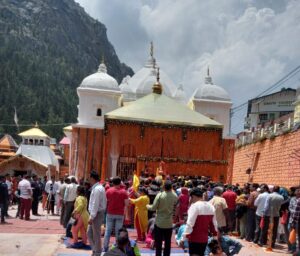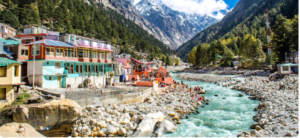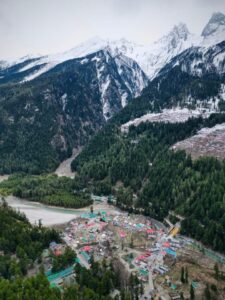Nestled in the Garhwal region of the Himalayas in Uttarkashi district of Uttarakhand, India, Gangotri is one of the most revered pilgrimage sites in the country. It forms an integral part of the Chota Char Dham Yatra, a sacred pilgrimage that also includes Yamunotri, Kedarnath, and Badrinath. Gangotri holds immense significance for Hindus as it is the origin of the holy river Ganges (referred to as Ganga in India), a river deeply intertwined with the cultural, spiritual, and historical identity of the country.
Beyond its religious importance, Gangotri is also famed for its breathtaking landscapes, challenging trekking trails, and pristine natural beauty. This combination of divinity, adventure, and nature makes Gangotri a uniquely important destination.

The Religious and Mythological Significance
The spiritual essence of Gangotri is rooted in the mythological and religious history of India. According to Hindu mythology, the River Ganges is believed to have descended from the heavens to earth at this very place. The legend recounts that King Bhagirath, after severe penance, convinced Lord Brahma to allow Ganga to descend to the earth from the heavens to purify the ashes of his ancestors and liberate them from their sins.
As the force of the descending river would have been too strong for the earth to withstand, Lord Shiva contained the river in his matted locks, allowing it to flow gently as the River Ganga. This divine event is commemorated at Gangotri, and the river is revered as “Mother Ganga,” symbolizing purity, devotion, and forgiveness.
The Gangotri Temple, perched at an altitude of 3,100 meters above sea level, stands as the principal shrine here. The temple, dedicated to Goddess Ganga, was built by a Gorkha commander named Amar Singh Thapa in the early 19th century. Thousands of devotees visit the temple every year, especially during the summer months (from May to October), to offer their prayers and to perform rituals seeking blessings and spiritual purification.
The Spiritual Importance of the River Ganga
For Hindus, the Ganges is more than just a river; it is a life-giving, sacred entity. Bathing in the waters of the Ganges is believed to wash away one’s sins and help the soul attain moksha (liberation from the cycle of life and death). At Gangotri, pilgrims often take a dip in the icy waters of the river to seek salvation and blessings. Although the actual source of the Ganges is the Gaumukh Glacier, located around 19 kilometers upstream from Gangotri, it is at Gangotri that the river is first worshipped and venerated.
The Gangotri Glacier, the largest glacier in the central Himalayas, feeds the river. The sheer purity of the water and the untouched natural surroundings evoke a profound sense of peace and spiritual connectedness among visitors. Bhagirathi River, which is formed from the glacier’s meltwaters, later merges with the Alaknanda River at Devprayag, and from there, the river is officially known as the Ganga.

A Gateway to Natural Beauty and Adventure
Gangotri is not only significant for its religious importance but also for the incredible natural beauty it offers. Set against the backdrop of snow-clad Himalayan peaks, Gangotri is surrounded by lush greenery, towering pine and deodar forests, and serene valleys. The Gangotri National Park, which covers the surrounding areas, is a haven for biodiversity, featuring endangered species like snow leopards, Himalayan tahr, musk deer, and more. For nature lovers and wildlife enthusiasts, this is a place of unparalleled beauty and tranquility.
The trek from Gangotri to Gaumukh is one of the most popular trekking routes in the region. The route offers a once-in-a-lifetime experience of walking amidst towering Himalayan peaks, alpine meadows, and sparkling streams. Trekkers often make their way to the Tapovan meadows, known for their panoramic views of Mount Shivling and other majestic peaks. The trek is not only physically challenging but also spiritually uplifting, as it takes the traveler through one of the most pristine and revered landscapes in India.
Adventure enthusiasts are also drawn to Gangotri for mountaineering and rock-climbing opportunities. The towering Mount Shivling (6,543 meters), considered one of the most beautiful and challenging peaks to climb, attracts mountaineers from all over the world.

Cultural and Environmental Significance
Gangotri’s cultural fabric is deeply woven with the local traditions of the Garhwal region. The town, though small, is vibrant with the presence of sadhus (holy men), pilgrims, and local inhabitants, who continue to preserve the traditions of worship and service to the river Ganga. The Aarti ceremony, conducted every evening at the Gangotri temple, is a mesmerizing spiritual experience, as the sound of chanting and the glow of oil lamps fill the air.
Additionally, the environmental significance of Gangotri cannot be overlooked. The retreating Gangotri Glacier, caused by climate change, is a major concern for environmentalists. As the primary source of the Ganges, any ecological disturbance to this glacier can have far-reaching effects on the flow of the river and the communities that depend on it downstream.

Gangotri is more than just a pilgrimage destination—it is a place where spirituality, nature, and adventure intertwine seamlessly. The town and its surrounding regions offer not only a deep connection to Hindu mythology and spirituality but also some of the most awe-inspiring landscapes in the world. For pilgrims, it offers a path to salvation through the holy waters of the Ganga. For trekkers and nature lovers, it offers a gateway to the pristine, unspoiled beauty of the Himalayas. Thus, Gangotri’s fame is a blend of its religious reverence, natural grandeur, and ecological significance, making it a place of both spiritual solace and earthly adventure.